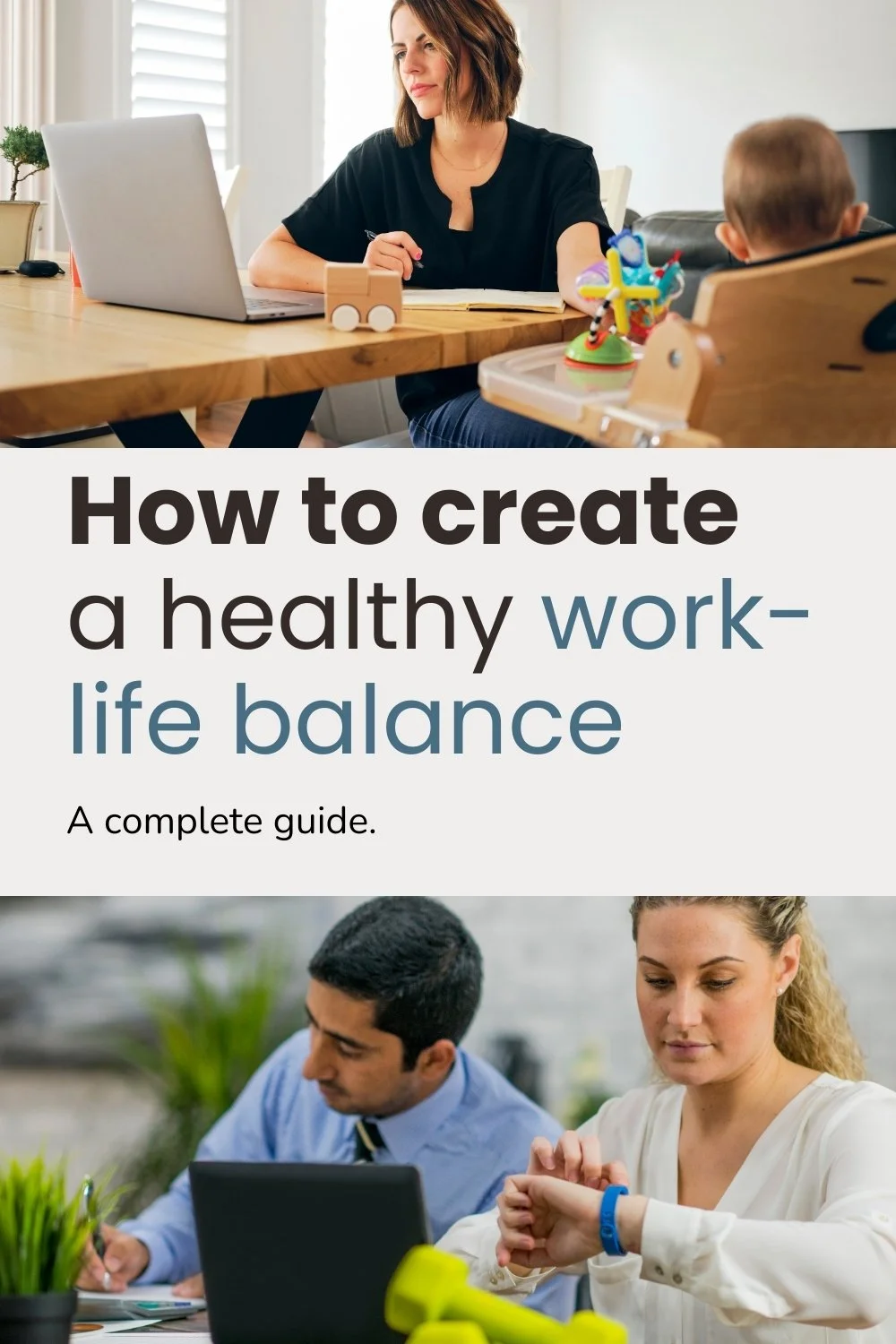How to create a healthy work-life balance: The complete guide
This guide isn’t theory. It’s shaped by years of coaching sessions, real conversations, and the practical shifts that people tested until they found what actually works.
What work-life balance really means (and why it matters)
When most people hear “work-life balance,” they imagine some magical 50/50 split where work stays in its tidy box and life flows perfectly in the other. Real life doesn’t work like that. Deadlines creep in, family needs shift, and sometimes your boss’s “quick request” eats the whole evening.
Work-life balance isn’t only about counting hours; it’s about rhythm. It’s making sure work doesn’t swallow the rest of your life, and life doesn’t constantly clash with your work. A healthy balance gives you enough energy and time to show up well in both places.
Why does it matter so much? Because when the balance is off, the ripple effects show up everywhere:
Your body feels it through stress, fatigue, or restless sleep
Your relationships feel it through missed dinners, distracted conversations, or quiet resentment
Your work feels it too. Burned-out brains don’t produce their best ideas
On the flip side, when you protect the balance, everything (and everyone) benefits. You feel sharper and calmer at work, more present with the people you love, and more like yourself. Balance isn’t a luxury. It’s the foundation that keeps both your career and your life sustainable.
This guide will walk you through three steps:
Reflect on where your balance is slipping
Take action with small, doable shifts
Go deeper to protect your balance long-term (coming soon!)
By the end, you’ll have a clearer sense of where your energy is going, what’s worth adjusting, and how to start building a healthier rhythm for yourself.
Step 1: Reflect on where you’re out of balance
Before you can fix your balance, you need to see clearly where it’s slipping. The tricky part? Most of us don’t notice how far we’ve drifted until someone else points it out, or until we’re so tired that even fun feels like another chore.
Having a healthy work-life balance doesn’t mean splitting your time 50/50 between your home life and your work life. It means finding a rhythm where you can meet your responsibilities without draining every ounce of your energy or sidelining the things (and people) you care about.
Here are some ways to reflect on where you’re really at:
1. Track your time and energy, not just your hours
It’s easy to say “I work 40 hours a week,” but what matters is how much energy you’ve got left for life outside of work.
For example, Sam worked a standard 9–5, but by the time she got home, she had zero energy for her kids. She realized her workdays weren’t too long, but they were relentlessly draining. That’s an imbalance in energy, not time.
2. Notice what you keep putting off
If the laundry piles up, your gym shoes collect dust, or you can’t remember the last time you called a friend back, those neglected areas are red flags.
For example, Raj noticed he hadn’t touched his guitar in six months, even though playing used to relax him. The more he delayed it, the more work felt like his whole identity.
3. Listen to the people around you
Complaints, subtle digs, or quiet sighs at the dinner table often mean your balance is off.
Phrases to listen for:
“You’re always working.”
“Do you really need to check that right now?”
“We never see you anymore.”
For example, Taylor’s partner teased, “I should book an appointment just to see you.” It stung, but it was the wake-up call Taylor needed.
4. Ask yourself: Am I proud of how I spend my time?
This question is designed to make you check whether you are living in alignment with your values. If your schedule doesn’t reflect your values, you’ll feel stretched thin no matter how many breaks you take. Our bodies know if we’re straying, even if our brains don’t pick up on it.
For example, Ana valued family, but when we looked at her calendar, her boss had more scheduled time than her kids did. No wonder she felt off.
5. Check for physical warning signs
Chronic stress doesn’t just stay in your head. It shows up in your body.
For example, Frequent headaches, poor sleep, and that “Sunday dread” knot in your stomach are all balance alarms.
HEY!
It’s tempting to skip reflection and go straight to solutions. But if you don’t know your starting point, you’ll try strategies that don’t fit your real problem. Reflection gives you the clarity you need to actually make changes that stick. Don’t skip this step.
Reflection activity
Ask yourself these questions:
Which part of your life feels neglected right now?
When do you feel most energized vs. most drained?
Have people close to you hinted (or outright said) you’re working too much?
If you looked at your last week, would you feel proud of how you spent your time?
Step 2: Take action with small, doable shifts
Reflection helps, but real change happens when you act.
These tips are practical. Try a couple and see how small changes can bring big relief.
Important tip: If the people in your life are already telling you your balance is off with phrases like, “You’re always working,” “I never see you anymore,” or “Do you really need to check that right now?”, take those words seriously. Outside feedback is often a mirror showing you what you’ve been ignoring.
Here are ten ways to start shifting:
1. Set a clear “stop time” for work
Work has a sneaky way of bleeding into everything. Choosing a cutoff time tells your brain, we’re done.
Client example: Mark set a firm 7 p.m. cutoff time for work. Initially, he would often slide past that limit with the excuse of “Just one more email.” However, once he decided to set a reminder alarm on his phone, he was able to reclaim his evenings more effectively. As a result, he now enjoys cooking dinner with his partner three nights a week, creating quality time and strengthening their relationship.
Outside feedback cue: If your family keeps commenting on your late-night laptop glow, this one’s for you.
2. Build a daily reset ritual
Even the smallest transitions can make a big difference. Whether it’s a brief walk around the block, a quick stretch to loosen up, or lighting a favorite candle, these simple actions send a clear message to your mind and body: “Work mode off, life mode on.” These little rituals help you shift gears and embrace the moments that truly belong to you, not your boss. This is especially important if you work from home.
Client example: Leila uses her dog’s evening walk as her daily reset. It keeps her from mentally dragging meetings into her night.
Outside feedback cue: If loved ones say you’re “still distracted” after work, a ritual can help you mentally arrive home.
3. Protect your sleep like it’s sacred
You simply can’t “punch through” exhaustion, no matter how hard you try. Establishing a consistent bedtime each night is the essential foundation for achieving true balance in your life.
Client example: Devin decided to create a “digital sunset” at 9:30 each evening. By swapping mindless scrolling for reading engaging novels, he successfully stopped his morning brain fog and started each day feeling clearer and more focused.
Outside feedback cue: If coworkers joke that you “always look tired,” this is your red flag.
4. Practice saying “no” (without apologizing)
Every time you say “yes” to extra work, you’re actually saying no to your own well-being and personal time. Setting boundaries isn’t selfish at all; in fact, they are a form of self-respect and absolutely essential for maintaining balance in your life.
Client example: Maya replaced “Sure, I’ll take it” with a more thoughtful response: “My plate is full right now. Which task should I set aside to make room?” Suddenly, her workload became much more manageable and less overwhelming. It’s easy to blame your manager for piling the work on, but if you aren’t letting them know it’s too much, you’re the one at fault.
Outside feedback cue: If friends stop inviting you places because you “never have time,” it’s a sign you’re overcommitted.
5. Time-block your priorities
Schedule life-giving activities just as firmly and non-negotiably as you schedule your important meetings. When these meaningful moments are written into your calendar, they are much more likely to happen. No exceptions. Period.
Client example: Raj time-blocked 30 minutes for guitar each evening. That slot became untouchable, and his evenings felt more like his.
Outside feedback cue: If your kids are asking, “When will you be done?” this strategy makes your answer visible.
6. Batch your work (and your chores)
Constant task-switching quietly steals your energy throughout the day. By grouping similar tasks together, you create a natural flow that helps you stay focused and productive.
Client example: Nina thoughtfully batched all her errands into Saturday mornings. Gradually, her evenings stopped disappearing into long car rides, giving her more time to unwind and enjoy.
Outside feedback cue: If your partner complains you’re “always running out the door,” batching can help free up shared time.
7. Create physical boundaries
Your brain needs clear cues to recognize when work is truly over for the day. Even small space hacks, like tidying your desk or switching off your computer, can make a big difference. These little actions help signal to your mind that it’s time to relax and shift focus away from work tasks.
Client example: Alex, while living and working in a cozy (tiny) studio apartment, carefully set up a folding screen to create a little private office space. Closing the screen was more than just a physical action; it meant being officially “off duty” and ready to unwind.
Outside feedback cue: If others ask, “Are you still working?” while you’re eating at your laptop, it’s time for a boundary.
8. Delegate or share the load
Balance doesn’t mean doing everything all by yourself. It’s about sharing responsibility and working together, which helps lighten everyone’s load and brings a greater sense of harmony to life.
Client example: Tanya stopped being the “household manager” by default, which used to weigh heavily on her every day. A weekly family meeting brought everyone together to clearly shift responsibilities and chores, allowing each person to take ownership. As a result, she stopped drowning in overwhelming mental lists and finally found more peace and balance in her home life.
Outside feedback cue: If family members hint they feel ignored because you’re “always busy with tasks,” this is a signal to share those tasks.
9. Schedule and take real breaks
Skipping breaks doesn’t actually make you more efficient; in fact, it just causes you to burn out much faster and lose focus over time. Taking regular breaks is essential for maintaining your energy and productivity throughout the day.
Client example: Javier thoughtfully set a timer to remind himself to stretch every hour throughout the day. As a result, his persistent back pain noticeably improved, and he found that his focus and concentration lasted much longer than before.
Outside feedback cue: If coworkers keep telling you to “take a break already,” they see what you don’t.
10. Reconnect with what brings you joy
Balance is about creating more life, not simply doing less work. It means intentionally making space for the activities and moments that genuinely light you up and bring you joy.
Client example: Claire rejoined her book club after some time away. At first, it felt like a small indulgence, a nice treat just for herself. But before long, it quickly grew into something much more important, an essential part of her identity and sense of self.
Outside feedback cue: If people close to you say, “I miss the old you,” chances are joy has fallen off your calendar.
Helpful resources to explore
Books worth exploring
*Essentialism: The Disciplined Pursuit of Less by Greg McKeown
A great reminder that balance isn’t about doing everything, it’s about doing the right things.*Set Boundaries, Find Peace by Nedra Glover Tawwab
Practical scripts and strategies for saying no without guilt (Hello, Step 2 strategy #4!).*Burnout: The Secret to Unlocking the Stress Cycle by Emily and Amelia Nagoski
A research-backed, compassionate guide on stress, rest, and why balance feels so hard for women, especially.*The 4-Hour Workweek by Tim Ferriss
A bit flashy, but useful for rethinking delegation, efficiency, and time freedom.
*Heads-up: Some of the links on this page are affiliate links, which means I may earn a small commission if you choose to make a purchase, at no extra cost to you. I only recommend tools and resources I genuinely believe are helpful. Thank you for supporting the work I do here.
Podcasts worth exploring
The Calm Collective Podcast (topics on slowing down and living intentionally)
The Balanced Life with Robin Long (short, practical episodes about balance, self-care, and health)
WorkLife with Adam Grant (research meets real-world advice on how to rethink work)
The Lazy Genius Podcast by Kendra Adachi (helpful reframes on balancing tasks, routines, and priorities).
Websites and Apps worth exploring
RescueTime (app): Helps track where your hours actually go on your devices.
Forest (app): Keeps you off your phone while you focus on what matters.





